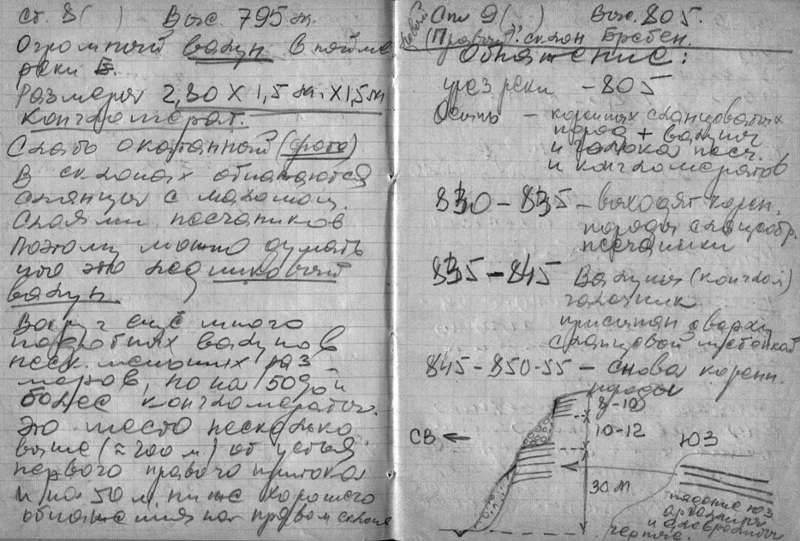
iStudy for Success!
Online learning tutorials for essential college skills.
iStudy would like to acknowledge Janice Smith for revising the content of this module.
Assembling a good set of notes is an essential component of successful learning in college. Far too often, students have the experience of reviewing worthless notes. Unless you have an extraordinary memory, effective note-taking will be very valuable to you throughout your college and professional careers.
Part of the challenge in taking good notes is that teaching styles vary from instructor to instructor—as do lecturing styles. Some instructors are well organized and some wander; some are storytellers who leave it up to the student to determine the significance of the story. It is essential for you to determine an instructor's lecture style and the method he or she uses to divulge important ideas. This will help you determine what information should be included in notes taken during a lecture.
This tutorial addresses academic survival skills and requires active use of writing, speaking, and other forms of self-expression. The tutorial also provides opportunities for information gathering, synthesis, and analysis in solving problems and in critical thinking. When you finish this tutorial, you should be able to:
Read about the basics of taking notes and complete the included activities.
Note: All external links in this tutorial will open in a new window or tab.
 Deena: I just returned from a class where I could hardly follow what the instructor was trying to teach us.
Deena: I just returned from a class where I could hardly follow what the instructor was trying to teach us.
Brian: I know what you mean. All five of my instructors teach in different ways. Some are very organized, while others wander all over the place.
Heather: Wander! Sometimes I think they're actually lost.
Deena: This one professor I have likes to tell stories, but he leaves it up to us to figure out which stories are important to remember.
Brian: The point is that because all of our instructors use different styles when they lecture, it is important to figure out what style they are using so we can take good notes.
Deena: I think we all could improve our note-taking skills.
Brian: Learning to take good and accurate notes should help with our data collection assignment.
Deena: Well then, who wants to gather up some information about note-taking and bring it back to share with us?
Brian: I guess I could do it.
Heather: I can work on it too. So, Brian, when do you want to meet to brainstorm and develop our sharing strategy? I have a class coming up.
Brian: That's fine. I'm going to the learning resource center. Maybe I can pick up some material there while I wait for you.
Heather: Sounds good.
Brian: See you later in the student lounge.
(Brian and Heather meet at the student lounge.)
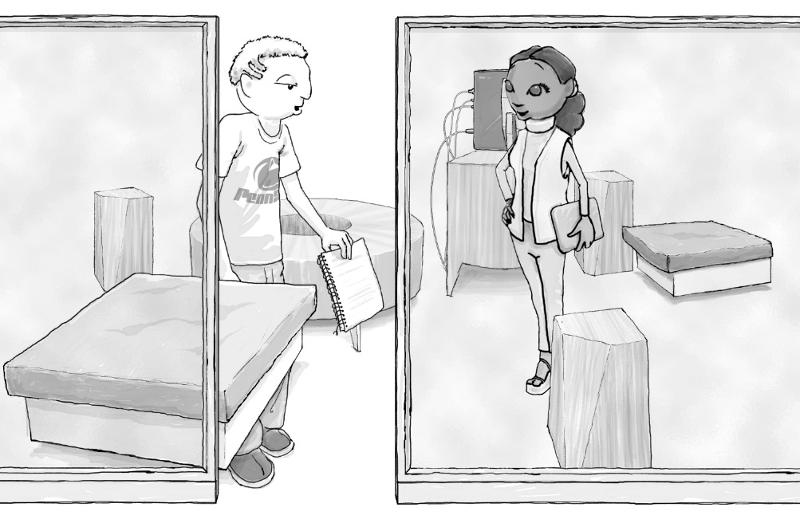 Heather: Hi, Brian. So what did you find out?
Heather: Hi, Brian. So what did you find out?
Brian: I didn't spend a lot of time researching note-taking, but I did ask a teaching assistant. He said that there are three different stages of a lecture to consider: before lecture preparation, activities during the lecture, and post-lecture debriefing.
Heather: That sounds like a good start, why don't we use those?
Brian: How about I take "preparing before the lecture" and "activities during the lecture." You take "activities during the lecture" and "post-lecture debriefing."
Heather: So we both get to do "activities during the lecture." We can tie that together later.
Brian: How do you want to present it?
Heather: I like to use graphics or visuals to make my ideas clear. So I guess we could use some presentation software and display information on a video screen.
Brian: Great.
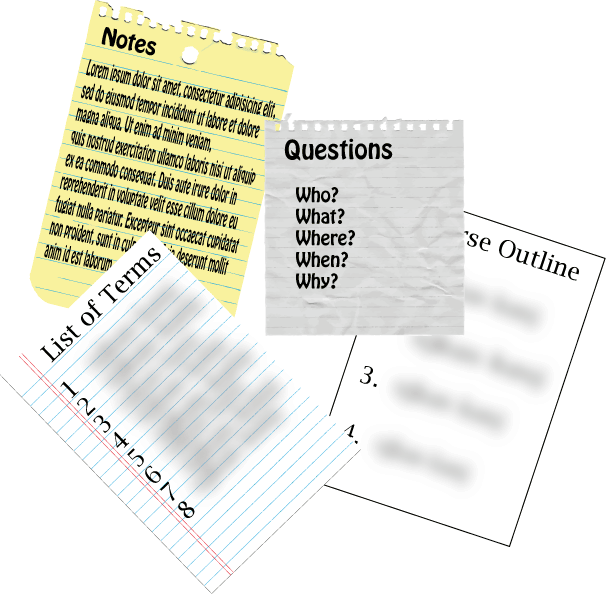 Being prepared for class includes completing assignments as well as looking ahead at what will be covered in the next class. Following are some tips for what to do to prepare for class and what to do during class:
Being prepared for class includes completing assignments as well as looking ahead at what will be covered in the next class. Following are some tips for what to do to prepare for class and what to do during class:
[top of page]
(At the next group meeting, Brian and Heather tell Deena what they learned about note-taking.)
Brian: The preparation stage of note-taking occurs before it is time to actually take notes. You begin the process by taking a look at why you should develop good note-taking skills.
Heather: In other words, these skills will hone your active listening abilities.
Brian: A good note-taker will increase his or her comprehension and retention skills.
Heather: You understand things better and remember them longer!
Brian: Next, if you apply good note-taking skills, you should be able to create a concise outline of what is meaningful, what things relate to other things, and what concepts depend on others. Any questions yet?
Heather: Note-taking should clarify ideas and embellish the material presented.
Deena: Yeah, right. Even if you don't have any idea what they are talking about?
Brian: Good question, Deena. Can you save that thought? We will get to that in just a moment.
Heather: Basically, unclutter difficult concepts and expand on them beyond what is in a lecture. You know, go the extra mile to kind of make whatever the topic is "your own."
Brian: Okay, and lastly, develop excellent review resources.
Deena: Okay. Now you've got me. What do you mean by "review resources"?
Brian: You can use your notes as a reference or resource. I know some people keep their notes for their entire college career and beyond. Someday, you may need to look something up that you know you learned but can't recall.
Deena: So if you took inaccurate notes you would probably get it wrong again.
Heather: That's true. If you share your notes with someone else, it could affect their grade. Okay. We all agree that there are definite purposes for taking accurate notes, but to take the greatest advantage of a lecture, we need to do some prior preparation.
Brian: Here are some steps to follow. If you put some effort into preparation, you'll be ahead of the game.
Deena: I don't think of a lecture as a game. I shouldn't have to try to drag information out of an instructor.
Heather: I agree, Deena, but if you are to get the most from what is being presented, you have to be prepared. The purpose of the lecture is not to read the text to you, but to stimulate your thought processes. If you don't have the slightest idea what the instructor is talking about, you'll be lost.
Brian: You can also miss opportunities to ask questions about what you don't understand.
Deena: You mean like definitions of unfamiliar words? And concepts?
Heather: Right. Preparing ahead of time will help you write down questions and obtain clarification. If you don't understand something, there are probably many others who don't either.
Deena: So, what should I do if I don't get the information during the lecture?
Brian: Make a note of it and ask the instructor before the lecture ends.
Heather: Sometimes, just like with one word or term, there may be entire portions of the text that you don't understand. It is our responsibility to make sure that we fully understand the materials. The information presented in a lecture is a vital part of that.
Deena: I don't think we should leave out making an appointment with an instructor to get additional clarification if we need it.
Brian: That's right, and we can also ask classmates what they got from the lecture.
Deena: I might if I was sure they understood the material.
Heather: Probably the only way you could know whether they understand is if you are well prepared.
Deena: Right. If we're well prepared, we can ask good questions to get clarification.
Brian: You can also set up your notebook. While it may seem obvious, you should either have separate sections or separate notebooks for each class.
Deena: I sometimes have formulas for a class that need to be transferred to a lab notebook, which is going to be graded.
Heather: In that case, there may be a different way you want to take and organize your notes for that class to make the transfer process easier.
Deena: So the way you set up your notes can make your note-taking more effective?
Brian: That's right.
Heather: And that could make a difference in your grade.
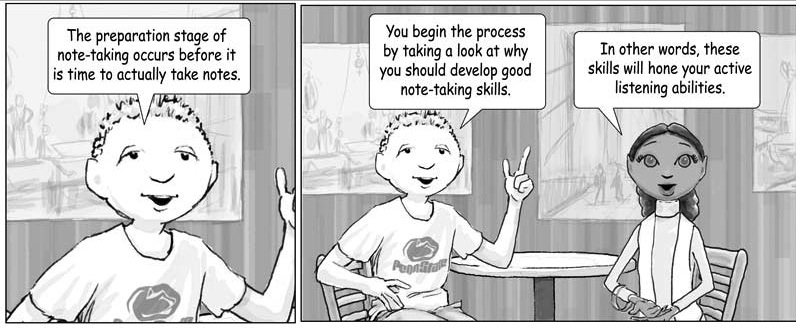
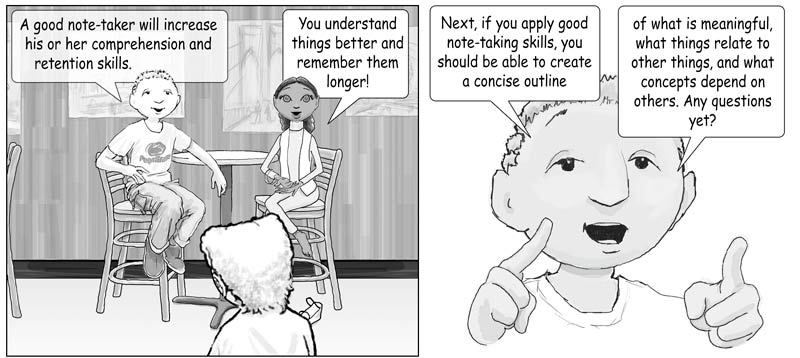
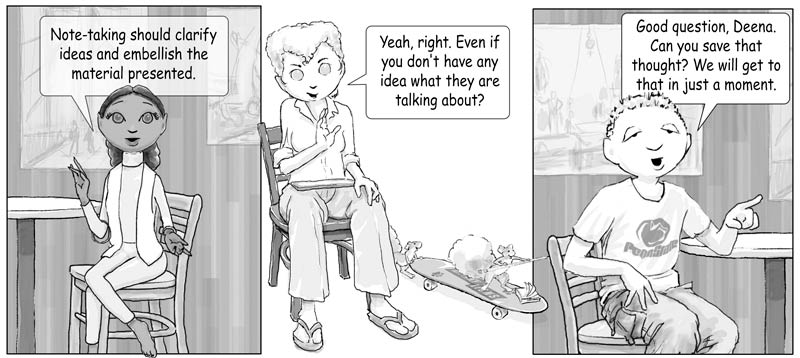
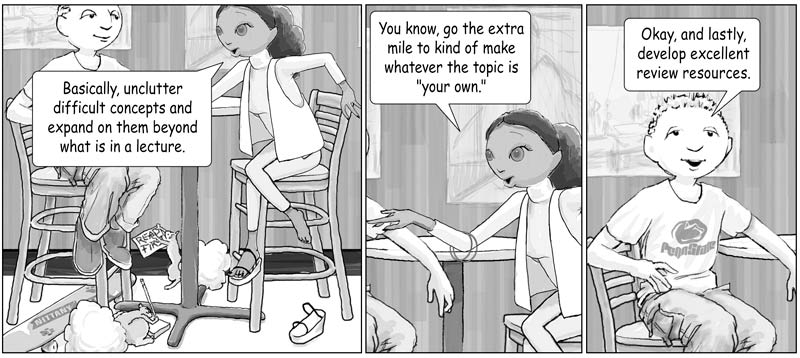
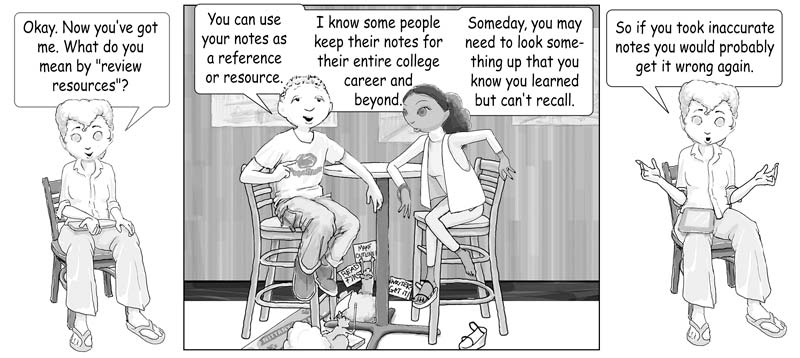
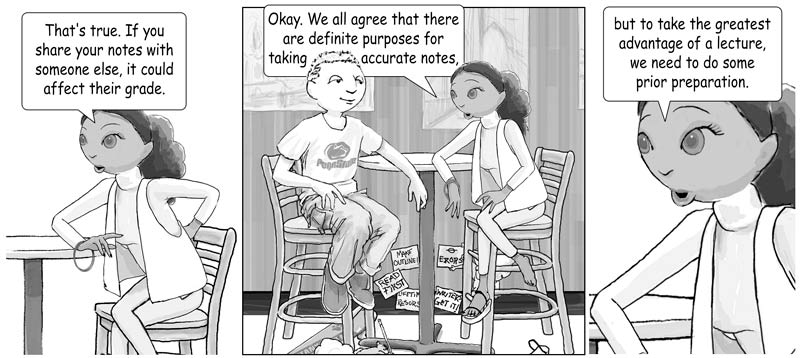
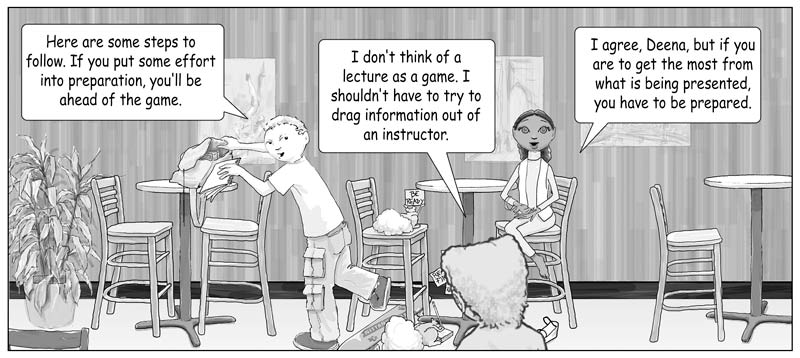
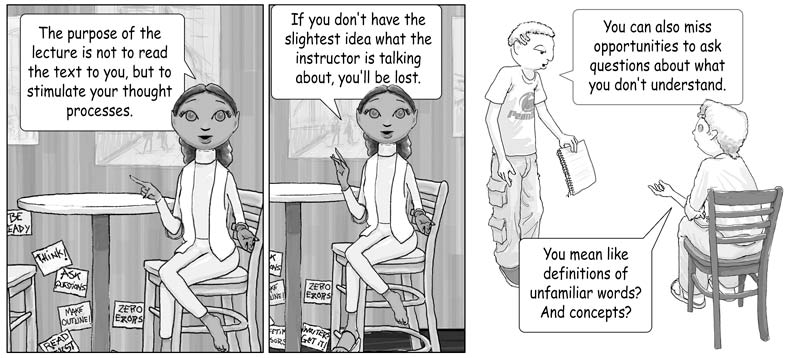
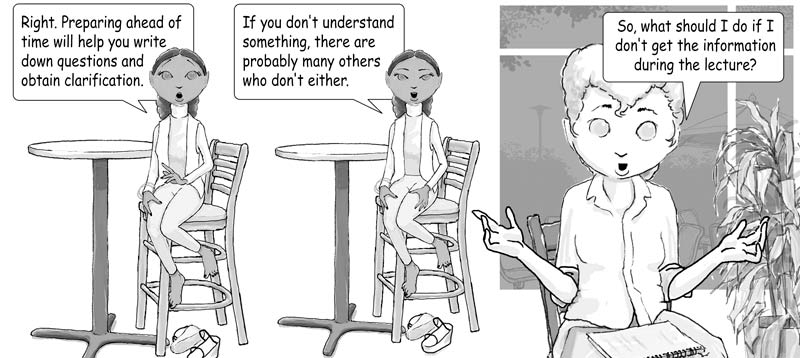
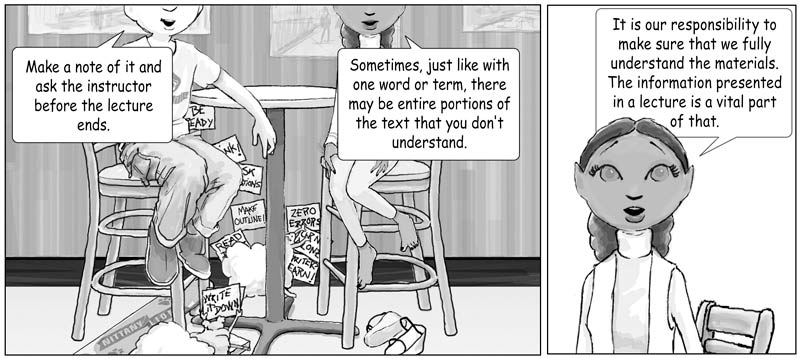
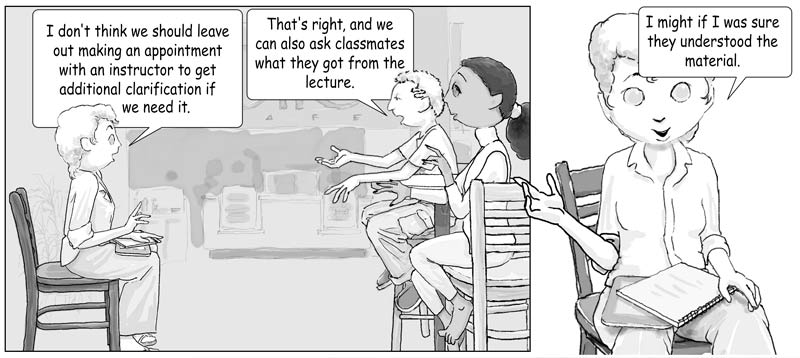
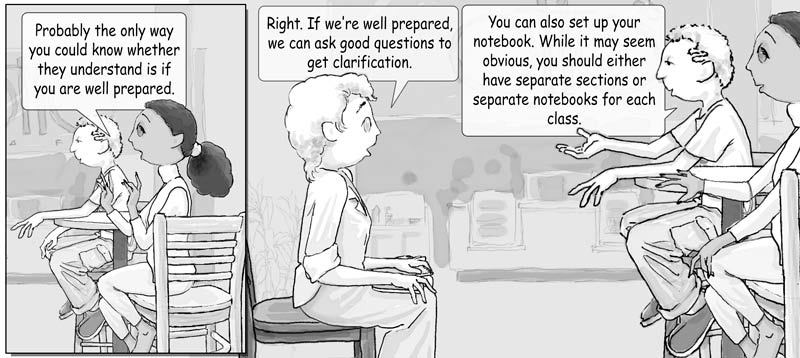
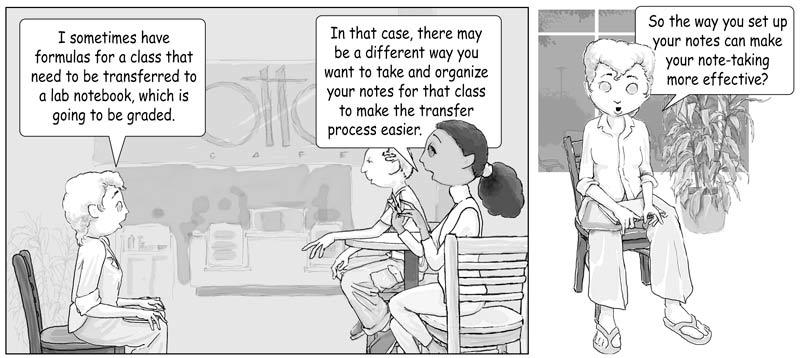
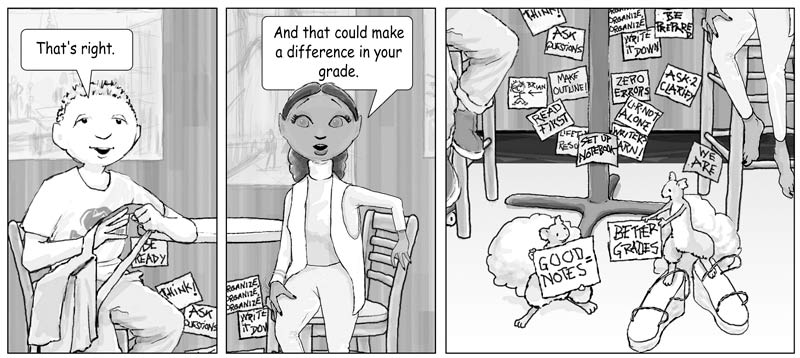
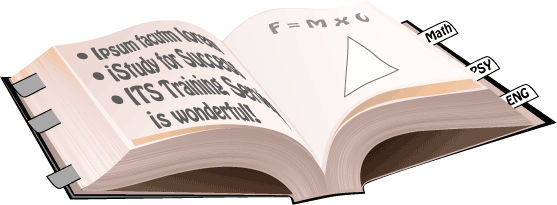 Structure and organization are key to maintaining accurate notes. Following is a list of guidelines and tips for setting up a notebook and keeping your notes intelligible.
Structure and organization are key to maintaining accurate notes. Following is a list of guidelines and tips for setting up a notebook and keeping your notes intelligible.

One of the habits to develop when taking notes is to listen for key words, clues, hints, patterns and other techniques instructors use when presenting or lecturing. Some of these tips for finding clues and patterns in a lecture include:



Another note-taking "best practice" is to review your notes as soon as possible.
 Brian: So, let's see - we have covered what to do to prepare for a lecture and what to do during the lecture.
Brian: So, let's see - we have covered what to do to prepare for a lecture and what to do during the lecture.
Heather: Now that we have our notes, the question is: Are we finished?
Deena: I hope so! Just kidding.
Brian: Deena, what do you think we should do next?
Deena: I'm not sure what you mean. Do you want to conclude your presentation?
Brian: Good to see you are asking for clarification. What I meant to ask was, what should we do with the notes after we have taken them?
Deena: Okay. I think you should review the notes.
Heather: Brian, how long would you wait before reviewing your notes?
Brian: Oh, until just before an exam.
Heather: Deena, how long would you wait?
Deena: It depends on how busy I am. I like to review them as soon as possible. That way I remember them better.
Brian: Deena, what do you do when you review?
Deena: I like to fill in facts, figures, and examples while the lecture is still fresh in my mind. I also like to clear up misunderstandings and fill in missing information.
Brian: Hmmm. It sounds like there may be more to that statement than meets the eye.
Deena: So, why is it important to review your notes so soon after a lecture? I sometimes want to get as far away from them as possible.
Heather: Unless you review within twenty-four hours, or at least before the next lecture, you will be relearning the material instead of reviewing.
Brian: In other words, the sooner you review, the better your retention.
Deena: Sometimes I copy notes that same evening because I write fast and can't always read my notes.
Brian: That's okay, Deena. There is a better way than just recopying notes. If you reorganize and put them into your own words, you'll retain the information longer and be able to recall it easier.
Here is an easy way to remember the most important points of note-taking: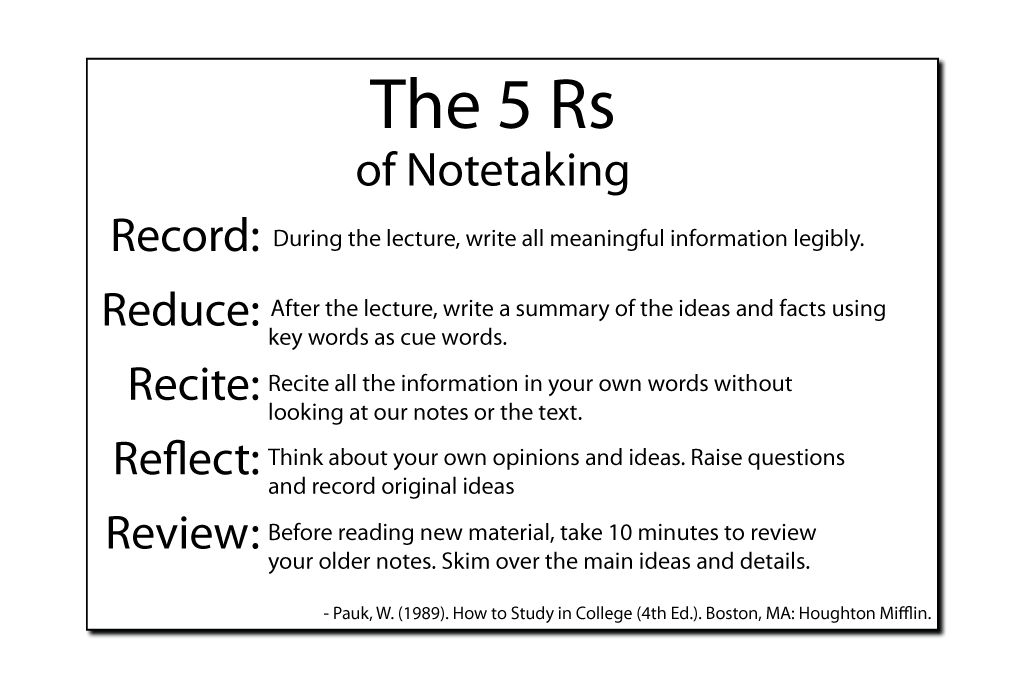
Record: During the lecture, write all meaningful information legibly.
Reduce: After the lecture, write a summary of the ideas and facts using key words as cue words. Summarizing as you study helps to:
Recite: To study properly, you must recite all the information in your own words without looking at our notes or the text.
Reflect: Think about your own opinions and ideas as you read over your notes. Raise questions, then try to answer them creatively. Record original ideas in your notebook and review them regularly. Use your creative ideas when answering exam questions, in classroom discussions, and when writing papers.
Review: Before reading or studying new material, take ten minutes to quickly review your older notes. Skim over the main ideas and details. Review enhances your retention of old material while adding new material to your memory.
- Pauk, W. (1989). How to Study in College (4th Ed.). Boston, MA: Houghton Mifflin.

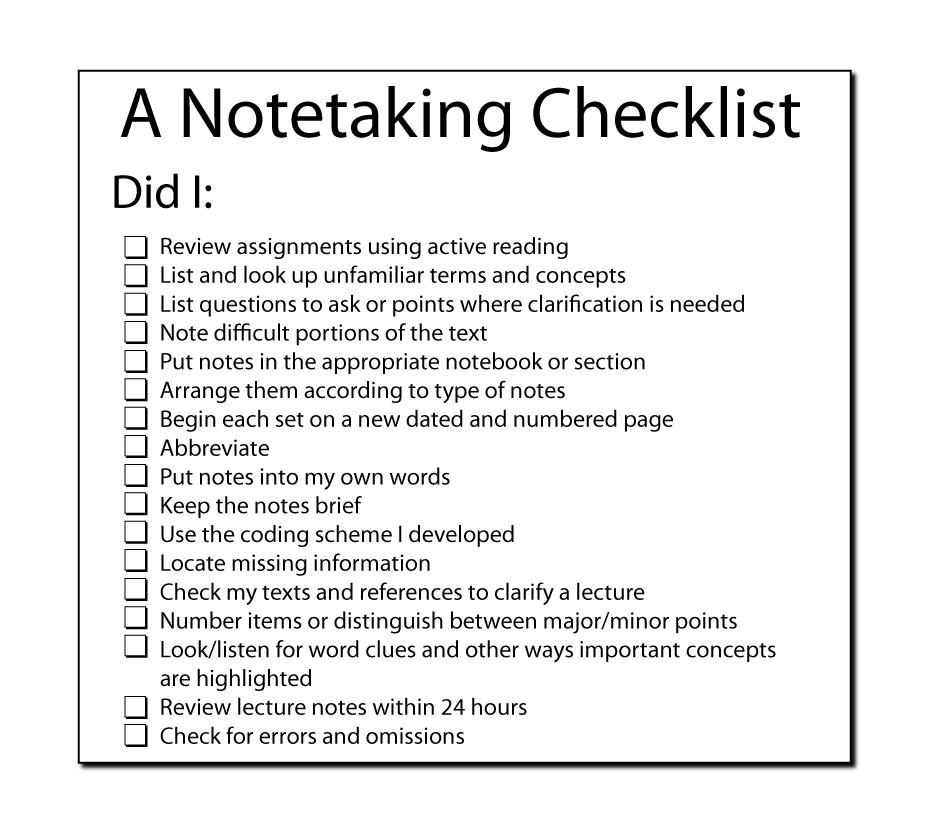 One of the things you can do to ensure that you are doing a good job of taking notes is to work with a checklist. Use the following checklist several times to make sure you are using good note-taking practices. Note the date or occasion when you practiced good, active note-taking and check off the elements you completed. You may want to add some of your own hints to your list.
One of the things you can do to ensure that you are doing a good job of taking notes is to work with a checklist. Use the following checklist several times to make sure you are using good note-taking practices. Note the date or occasion when you practiced good, active note-taking and check off the elements you completed. You may want to add some of your own hints to your list.
Did I?
* Indicates that the original Website is no longer available.
Effective note-taking takes practice, and even the very best students may lose track in a discussion or become confused about the objectives in a lesson. Don't become discouraged. Remember that the more you think about the lecture—i.e., listen actively and take good notes—the more you will understand. It is what you actually do with the ideas presented in class—or those generated in your thoughts through listening, reading and thinking—that are critical to your understanding and retaining the material.
This lesson has presented some ways for you to approach note-taking. There are almost as many ways to take notes as there are students taking them. You should use the methods that work best for you. Work on perfecting your own technique. You will find that effective note-taking is a skill that is of utmost importance in college, but it is also an ability that will be valuable in your professional life.
The purposes of good note-taking are to:
One aspect of preparation is setting up a notebook:
Tips for structuring and maintaining good, accurate notes:
Steps to take prior to the lecture:
Remember, this is your education. To get the most out of it, you will want to ask questions. Prepare a list of questions prior to class, especially on concepts you did not fully understand. Also, note concepts during the lecture that you do not understand and about which you want to ask questions. If you continue to feel that you don't understand, ask a classmate, make an appointment with your instructor, or visit the learning support center on your campus.
Following are the assignments embedded in the Note-Taking tutorial:
This tutorial is related to other tutorials on personal effectiveness, including active listening and active reading. Therefore, it is recommended that instructors introduce this tutorial to students in conjunction with other personal effectiveness tutorials.
In-Class Activity
The instructor should select a topic and have students review materials on the topic prior to meeting in class. The instructor should then give a short lecture on the material (between 10 to 15 minutes). Students should take notes on the content presented by the instructor.
Students then review the process by which they took notes. This review can serve as the basis for an in-class discussion about different methods students use to determine importance based on what the instructor says. Groups can be formed to discuss their methodology and then report on their insights/learning.
Through observing both the group's and the individual's activity, the instructor may assess student performance. Assessment criteria are as follows (Instructors supply the percentage weights):
|
Where |
Domain |
Activities |
% |
|---|---|---|---|
|
iStudy Tutorial |
Knowledge |
The student can list effective note-taking principles. |
|
|
In-Class |
Application |
The student can apply effective note taking principles in actual note-taking during the in-class activities. |
|
|
iStudy Tutorial |
Synthesis |
The student can give his/her examples regarding how effective note-taking positively affects his/her overall personal effectiveness. |
|
|
|
|
|
100% |